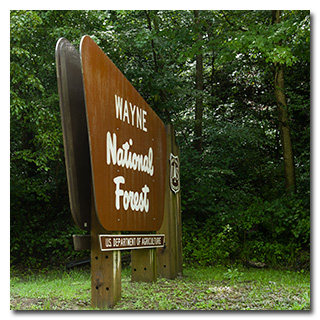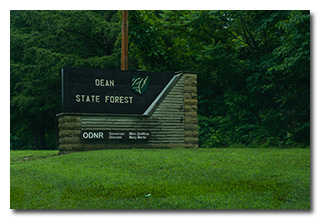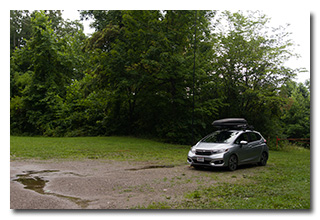
by William Eric McFadden
Support-Your-Parks Summer 2021 RATpedition, Day 1; parks seven and eight of ten
From the Dean State Forest website:
-
Located in the unglaciated hill country of extreme south central Ohio, Dean, one of Ohio's first state forests, was established in June 1916.
A wide variety of recreational opportunities exist at Dean State Forest. One popular activity is hunting. Deer, wild turkey, grouse, squirrel and rabbits are hunted in season at Dean. Several small ponds are located on the forest, and used by anglers. Mushroom hunting is becoming an increasingly popular activity.
Approximately 20 miles of bridle trails run throughout the forest and offer users a scenic ride through the woods. Hiking is also permitted on the bridle trails.
From the Wayne National Forest website:
-
The Wayne National Forest is a patchwork of public land that covers over a quarter million acres of Appalachian foothills of southeastern Ohio. The Forest is divided into three units managed out of two Ranger District offices located in Nelsonville and Ironton, with a field office in Marietta.
The Forest features over 300 miles of trails for hiking, all-terrain vehicle riding, mountain biking, or horseback riding in season. The trails are open to ATVs, mountain bikes, and horseback riders from mid-April to mid-December each year. Come visit the Wayne and hike or ride our trails!
Pictures
Description
 For the Parks on the Air program (POTA; link) Support Your Parks Summer 2021 Plaque Event
on the weekend of July 17-18, 2021, one member of the Southeast Ohio Radio Adventure Team
performed an aggressive two-day activation schedule with an overnight stop in Portsmouth, Ohio. The route of Eric McFadden, WD8RIF,
would cover over 300 miles, would include fifteen stops in two states, and would lead to twenty-one successful POTA activations with
421 QSOs made. Over the weekend, Eric would encounter rain, thunderstorms, and brilliant sunshine.
For the Parks on the Air program (POTA; link) Support Your Parks Summer 2021 Plaque Event
on the weekend of July 17-18, 2021, one member of the Southeast Ohio Radio Adventure Team
performed an aggressive two-day activation schedule with an overnight stop in Portsmouth, Ohio. The route of Eric McFadden, WD8RIF,
would cover over 300 miles, would include fifteen stops in two states, and would lead to twenty-one successful POTA activations with
421 QSOs made. Over the weekend, Eric would encounter rain, thunderstorms, and brilliant sunshine.
Following a successful activation at Waterloo Wildlife Area (K-8633) (link), a successful two-fer activation of Lake Hope State Park (K-1968) and Zaleski State Forest (K-5455) (link), a successful activation at Lake Alma State Park (K-1967) (link), a successful activation at Cooper Hollow Wildlife Area (K-8634) (link), and a successful activation at Jackson Lake State Park (K-1962) (link), Eric's sixth stop of the day was Dean State Forest for a two-fer activation of Dean State Forest (K-5438) and the Wayne National Forest (K-4521).
 Eric arrived at his planned operating location, a pull-off at a gated lane near the forest headquarters, at about 1915 UTC. During a light drizzle, Eric quickly set up his
28½' wire vertical on his Jackite 31' telescoping fiberglass mast and drive-on mount. Because of the threat of rain
and thunderstorms, and because of his aggressive time schedule, Eric set up his KX3 inside his car. Eric was on the air at 1334 UTC.
Eric arrived at his planned operating location, a pull-off at a gated lane near the forest headquarters, at about 1915 UTC. During a light drizzle, Eric quickly set up his
28½' wire vertical on his Jackite 31' telescoping fiberglass mast and drive-on mount. Because of the threat of rain
and thunderstorms, and because of his aggressive time schedule, Eric set up his KX3 inside his car. Eric was on the air at 1334 UTC.
The cell-signal at this location allowed Eric to use the POTA Spots website (link) to spot himself and to look for possible park-to-park (P2P) QSOs.
Eric began operations by finding a frequency to run on 40m and by 1956 UTC he had completed thirteen QSOs. This run included a P2P QSO with ND9M who was activating Greenbrier State Park (K-1575) in Maryland.
 Pausing to check POTA Spots for additional P2P QSO opportunities, at 1959 UTC Eric made a P2P QSO on 20m with WD5GRW who was activating
Eisenhower State Park (K-3005) in Texas. This was followed at 2002 UTC by a P2P QSO on 20m with K4NYM who was performing a two-fer
activation of Fort Cooper State Park (K-1870) and Withlacoochee State Trail (K-3667) in Florida.
Pausing to check POTA Spots for additional P2P QSO opportunities, at 1959 UTC Eric made a P2P QSO on 20m with WD5GRW who was activating
Eisenhower State Park (K-3005) in Texas. This was followed at 2002 UTC by a P2P QSO on 20m with K4NYM who was performing a two-fer
activation of Fort Cooper State Park (K-1870) and Withlacoochee State Trail (K-3667) in Florida.
Finding a frequency on 30m, Eric made an ten QSOs by 2019 UTC.
Because his aggressive itinerary didn't allow for much time at any of the parks, Eric tore down his station in order to proceed to his next location.
In all, Eric made twenty-six QSOs, including four P2P QSOs. All of Eric's QSOs were CW and were made at the 5-watt level.
Eric also submitted his log to the World Wide Flora and Fauna in Amateur Radio (WWFF; link) program for Wayne National Forest (KFF-4527).
(return)